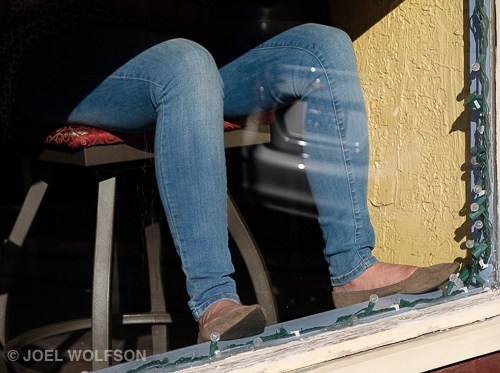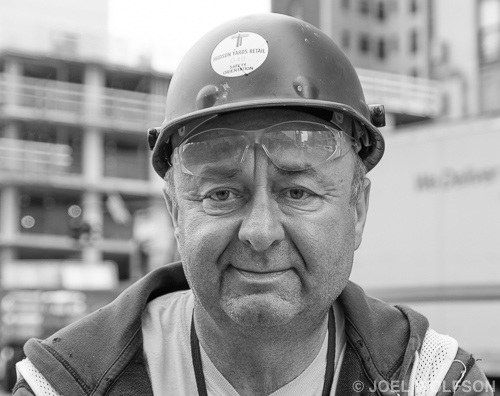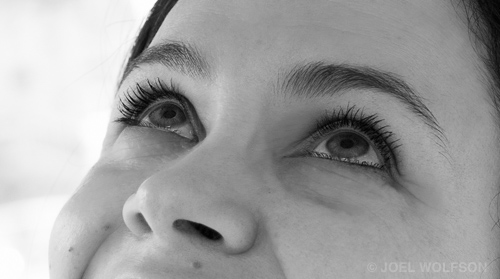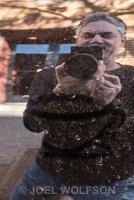Fuji vs Leica vs Sony…What to do?

Leica gear is beautiful but will likely always remain the domain of the wealthy hobbyist or the hardcore, sacrifice-what-it-takes-to-own-a-Leica photographer. I’m one of the few full time pros that uses Leica. Although, at the moment, I am Leica-less. Even though photography is my full time living and I depreciate gear on taxes it has always been a major decision any time I’ve bought Leica gear because of the huge expense.
Was it ever be totally practical to own Leica as a pro?
Nope. It’s about the feel of the camera and lenses and quality of the images. It’s also the inconspicuousness of a rangefinder. If you’re photographing people they’re less intimidated by a small camera that looks like something their grandfather owned back in the day. In the film days I could see the difference between my Leica and Canon images but could anyone else? Only if they had a trained eye and were examining the chromes with a loupe or scrutinizing a large print.
When Leica went digital
In 2007, after years of using Canon digital cameras and missing my Leicas I bought the first digital Leica M series body, the M8 and a few lenses, for which I used my entire annual equipment budget. It had a 10MP (megapixel) sensor and it was the best 10MP I’d ever seen. At the time, virtually every digital camera used anti-aliasing filters over the sensors. Leica didn’t, so combined with their great glass, the images were tack sharp right out of the camera. The only problem was that no matter how good it was, 10MP just wasn’t enough for the large prints that were my bread and butter income. I was used to the 16MP from my Canon 1Ds Mark II and had been wishing for even more resolution. After much consternation I sold the Leica gear and got a 1Ds Mark III (21 MP.)

Fast forward nine years. Without going into all the details of how I arrived here, I currently own a Sony full frame system based on the A7R II with mostly Zeiss glass and a Fuji X-Pro2 with a whole bunch of Fujinon XF lenses. I love the images I get from the Sony. The Zeiss and Sony lenses are fantastic and up to the task of the magnificent 42MP sensor in the camera.
Which camera do I reach for and carry with me most of the time? My Fuji X-Pro2. It has the feel of my old Leicas. In fact, even better in some ways. Not only does it have rangefinder viewing but with the flick of the lever that sits naturally against my middle finger I instantly have an EVF. It becomes a mirrorless camera complete with autofocus and all the other bells and whistles. It’s even a very good EVF- not quite as good as the Sony but close.
If I’m honest with myself, I feel like my Sony A7R II is a computer with a spectacular sensor attached to it. The X-Pro2 feels like a camera. It’s a pleasure to use. In fact the best part about it is I’m barely aware that I’m even using a camera. It’s a natural extension of me and I’m just concentrating on the moment and creating images. That is the definition of a great camera.

The Sony Quandry
I’m a little torn about what to do with my Sony system. I already sold my A7 II body but not the A7R II. There’s no denying that when I make large prints the Sony has that little extra bit of acutance and smoother transitions. Not that most of my patrons would notice, but I do. I’m somewhat tempted to sell just the body and wait a generation or two to see if Sony comes out with something more intuitive and fun to use. I’ve changed whole systems enough to know that the expensive part is replacing all the lenses. Also lenses hold their value much better than bodies.
For now the X-Pro2 is my new Leica.
Happy Shooting!
Joel
If you want to find out why I favor my X-Pro2 and all the different ways I use it, along with photos and the stories behind them, check out my series of blog posts at XProTour.com
Addendum/Epilogue:
For some, myself included, part of the traditional rangefinder experience is the ability to zone-focus with a 35mm or 28mm lens. This is faster than any autofocus and with zero lag time. You leave the lens on a small aperture, usually from f8-f16 and use the DOF scale to set a distance range that will keep everything in focus. This is easy to do with a manual focus rangefinder lens such as those from Leica/Zeiss/Voigtlander on a Leica M body. It is possible to do this with the X-Pro2 but admittedly not as easily as you have to use the digital scale in the viewfinder or on the back LCD. Even though I own 2 Fujinon XF lenses with a clutched focus ring you can pull back and instantly turn the lens to MF, I find the DOF scale not very useful as there aren’t enough marked increments. Another aspect of traditional MF rangefinders is the split-image focusing which tends to be positive and precise. It’s not something I miss on the X-Pro2 because I’m either being precise with AF by placing the focus point using the handy joystick or using peak focusing with focus assist (magnified image) in MF.
Recently a lot of good information has been coming out on Leica’s new (and currently very hard to get) M10 rangefinder. And yes, I’m thinking about it.
Joel Wolfson is an internationally published photographer who loves teaching as much as shooting. He shares his 30 years of experience as a working pro with other photographers and enthusiasts by way of his workshops, 1 on 1 training, webinars, articles, blog and speaking engagements. His technical articles have been translated for use in more than 30 countries yet he is best known for his artistic images of nature’s fleeting moments and unexpected views of everyday places around the globe. He is one of the pioneers of digital photography having conducted digital photography seminars for Apple and other corporations starting in the early 90s. His roster of notable clients includes numerous publications and fortune 500 companies. He currently works with great affiliates like Topaz Labs and Arizona Highways to have more avenues for working with those wanting to pursue their love of photography. His goal is to make learning and improving one’s photography easy, fun and rewarding.
A note about product links and affiliations: Some of the links I provide are affiliate links which means I get a small commission, with no additional cost to you, if you click it and end up buying something. It helps keep the lights on as well as supporting this blog and my other free educational resources and articles. So if you use them, thanks! It is always my goal to report my results in a straighforward manner whether or not it favors a particular product.


Just got a XPRO2 with 3 lenses. After a lifetime with Nikon, why? Because I always listed after a Nikon SP! (Actually got one stashed away, used it once.)
But my needs include a VG small weatherproof small camera I can carry hiking and backpacking.
I was ready to pull the trigger on an high density sensor Nikon when the XPro1 came out. So go figure.
Love the Fuji jpegs. The Fuji RAFs, not so much, but that’s because Adobe hasn’t gotten their raw converter well enough along for me.
Such is life.
Yes the film profiles for the JPEGs are great. There are actually several good raw processors out there now. My previous post compares 5 of them. YMMV.
Cheers,
Joel
Hi Joel,
Leica recently (and briefly) lent me an M plus a 50 summilux, and I was really keen to see how it stacked up against the X-Pro2
I won’t bored your readership with all the nitty gritty (I’ll bore mine at some point in the future!!!)
It was a decent experience and the two cameras (M and X-Pro2) are quite different in practice.
One thing that I did think though… the Fuji files held their own very well when compared to the M.
I’ve never really lusted after any of the Sonys, even though I know them to be superb, there’s something about them I just find too utilitarian
They seemed to have slowed down on releasing the A7 range. I’m surprised they haven’t done anything along the lines of the RX1R body shape, but with ICL of the A7 and a EVF, which I think would be very popular format.
Hey Adam,
Thanks for reading the article. I look forward to hearing about your experiences with the M and Summilux. There is something to be said for the simplicity of Leica rangefinders.
On a side note, I touted your blog and put a link to it on my post of shortcuts over on the Fuji-x forum 🙂
Literally in the same boat as you. I have an a7rii that technically is very good but I prefer the look of the images from my xt2 so have shot far more images with that camera. Colours are nicer for my tastes and there is something about the way an xtrans sensor draws light differently to a Bayer. Supposedly the extra green photosites allow for greater tonality against a regular 24mp sensor. Id agree. Like you said at 30×40 the Sony might look slightly better from a tonality perspective (its got a lot more extra resolution) but the files overall – colour, grain/noise pattern, edges from the xtrans have more of a filmic look. Couple that with a rangefinder body and for me too, Fuji is the new leica.
Great article. I recently picked up an XT1 and I shoot mostly Sony (A6000, A7S, RX100) and have loved the Fuji. I plan to keep my A7s and was looking to get the A7R2 and sell off my RX100 and A6000 but said why not and got the Fuji. No regrets. But I still may look to get the A7R2 but fear Sony will be Sony and announce an a9 or a7r3 that has what I really need for large printing and resolution plus video combo. Life.
I’ll continue to check in your site and look for more insight and pointers.
Clarence,
Thanks! It sounds like you understand the Fuji-Sony conundrum. They each have their assets.
Cheers,
Joel
Hi Joel
I also have the XP2 and A7rII. Many times I have contemplated selling the A7rII but I end up hanging on to it because it’s feature set is unbeatable. I’m an amateur photographer, in it for because it’s a hobby I love. Thanks for your article
Derrick,
You’re welcome and thanks for reading!
-Joel
Hi Joel
I currently shoot with the A7ii which I like but really don’t love (like you, I think!) I am contemplating changing to a Fuji system. Similar to what you say above I love big prints and want to make more of them. This has given me cause to wonder whether I should stick with Sony and upgrade to the A7Rii for the extra resolution.
At what size of print, in your opinion, is the difference noticeable? Is there a point at which the Sony becomes significantly better? Would you be happy with just Fuji for big prints?
Apologies for all the questions but I haven’t been in a position to look at big prints from either camera. I know photography isn’t about the gear, you just never know when that picture you want to print big comes along…
Thanks in advance
Jason
Hi Jason,
There are so many variables with print size that it’s difficult to answer. I did some print tests comparing the two cameras using prime lenses at optimum aperture and showed them to both experts and non-photo people. I used a landscape scene with lots of fine detail and printed them at 36×24 inches on glossy paper. I shot both low and high ISOs and made prints. Experienced photographers could tell a very slight differece but only examining a few inches away and more obvious on the high ISO shots. At normal viewing distances for a print that size you can’t really tell a difference. That said if you want to crop your image and blow it up the advantages of the Sony 42MP sensor will be more apparent. It will also be more apparent at high ISO. I have images I shot at ISO 8000 on the A7RII and printed 36×24 on metal that are flawless, even under scrutiny. I’ve also taken A7II images to 6 feet. I think the Fuji X-Trans on the X-Pro2 is pretty close to the A7II sensor in spite of FF vs APS-C.
Sorry I don’t have an easy answer but there are many variables. The type of subject and how carefully it was shot and with what lens all enter into the equation too. I would say the bottom line is that there is no question the A7RII images render detail better and the sensor is less noisy in low light. You could also use that same logic to buy a medium format camera too. It’s all about what you need to do with it and how much you like using it. If you don’t like using a camera then you won’t be out shooting and that would be a shame 🙂
I’ve had some responses from people having read this article telling me they use both Fuji and Leica. So there’s another thought for a solution if you can afford it.
I’m with Leica since 1979 and I will stay on this brand because liablity and the lasting value especialy at the Lenses? What is also very unic is the compatibility with the M typen but also with the newer cameras like SL and T! They are quite expensive, ok, but if you count everything together then for my opinion they are the best!